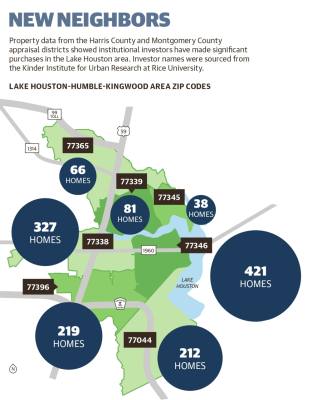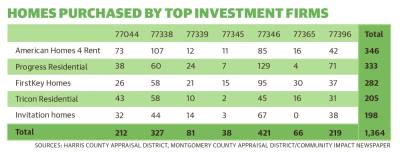While rising mortgages and low inventory are contributing to the trend, industry experts say potential homebuyers are also facing competition from real estate investment firms, or institutional buyers, which buy properties to sell or lease out as rentals of their own.
Nadia Evangelou, director of forecasting at the National Association of Realtors, described the firms targeting properties as “Wall Street-level” buyers looking for an investment.
“These are not mom-and-pop buyers,” Evangelou said. “They look to buy properties and communities on a large scale and make profit from them.”
According to a May NAR report, Texas led the nation in institutional buying with 28% of single-family homes purchased by investment firms in 2021—more than double the national average of 13%. The state also saw the second-largest percentage increase in properties bought by institutional buyers from 2020-21, climbing 4.6%.
Locally, NAR data showed institutional buyers accounted for 38% and 29% of all single-family properties purchased in Harris and Montgomery counties, respectively, in 2021.
Data from the Harris and Montgomery county appraisal districts shows nearly 1,370 homes in the Lake Houston area are owned by five institutional buyers and their subsidiaries: American Homes 4 Rent, Progress Residential, FirstKey Homes, Invitation Homes and Tricon Residential.
Five ZIP codes in the Greater Houston area housed between 5%-10% of the investor purchases, two of which are in the Lake Houston area. ZIP code 77346 includes 421 investment firm-owned homes, while 77338 has 327 investor-owned homes.
Deborah Rose Miller, a Realtor with Rose Realty, said the trend of investment firms turning homes into rental properties is not new.
“It’s not recent, but it has accelerated as of late,” she said.
“You see signs all over town [saying] ‘We’ll buy your property for cash.’”
While the Lake Houston area has also seen a rise in build-to-rent communities, Rose Miller said institutional buying has had a broader effect on the local housing market.
Low supply, high prices
Institutional buying trends have emerged as the housing industry is facing record lows in inventory. In May, HAR reported the Greater Houston area had 1.6 months of supply—its highest supply since October 2021. However, the market is still well below the six-month supply NAR considers to be a balanced market.
According to Rose Miller, investment firms often buy cheaper homes that would otherwise be targeted by first-time homebuyers, leaving those individuals with an even smaller supply of affordable homes.
“It’s impacting those first-time homebuyers that would probably be looking at around a $225,000-or-below home, [because] they now don’t have as much inventory or choice,” Rose Miller said. “Then, prices have gone up, so now they have to buy more than they want to spend and not get as much house for the money.”
According to HCAD data, the average home value for the 327 investor-owned homes in the 77338 ZIP code was roughly $206,800. Market data aggregator realtor.com shows the same ZIP code had an average home price listing of $249,000 as of May.
Further, Evangelou said investment firms often have more leverage in the market because they can purchase properties using cash and offer services the average homebuyer cannot.
In the last year, Lake Houston-area property values have increased, which Rose Miller said is due, in part, to the declining supply of homes.
According to realtor.com, the median listing home price in Humble rose from $275,000 in May 2021 to nearly $320,000 in May 2022. In Kingwood, the median listing home price jumped from $300,000 to $360,000 over the same time period.
Jennifer Wauhob, chair of HAR’s board of directors, said in a June 15 news release that recent market activity suggests conditions are calming.
“New listings increased by 9% in May, helping boost inventory to its highest level of the year, so hopefully we can begin to see signs of normalcy in terms of supply, demand and pricing,” Wauhob said in a statement.
Transition to rental properties
HAR data showed new single-family rental listings increased 28.6% from May 2021 to May 2022. Evangelou said institutional buyers converting the homes they purchase into rental properties is contributing to surging rentals.
“They create more rental housing, so even if rents rise, there is more supply,” Evangelou said. “With rising mortgage rates, it gives more options for people.”
Two such firms that have invested in this practice include American Homes 4 Rent, which owns 330 homes in the Lake Houston area, and Tricon Residential, which owns 189 homes in the Lake Houston area, appraisal district data shows.
According to a 2022 study conducted by researchers at the University of California at Berkeley, American Homes 4 Rent and Tricon Residential had invested millions of dollars in developing homes for rent as of the fourth quarter of 2021.
Charlie Kriegel—a real estate broker for Houston-based firm Winhill Advisors-Kirby, whose clients include Tricon—said these developments prioritize areas with favorable tax rates, relaxed homeowner association requirements and good school districts when targeting areas to develop.
Additionally, Evangelou said fast-growing formations of households—which entails a group of people living together—large millennial and minority renter populations, and still-affordable housing have contributed to the area’s status as a target for investors.
In the two Lake Houston-area ZIP codes with the highest numbers of investor-owned homes—77346 and 77338—the combined percentages of Black and Hispanic residents were 41.4% and 76.8%, respectively, according to U.S. Census Bureau data.
In the ZIP code with the lowest number of investor-owned homes—77345—the percentage of Black and Hispanic residents was 15.5%, per census data.
Build-to-rent communities
Firms that have bought properties have also been investing into developing build-to-rent communities.
David Howard, executive director of the National Rental Home Council, said two years ago 3% of NRHC companies were building homes for rent, compared to 26% in 2022.
According to Kriegel, many of his clients see build-to-rent communities as opportunities to see large returns on their investments.
“[Build-to-rent] allows investors to control cost, absorption rate, so it’s going to be the fastest-growing segment for the next five years,” he said.
Locally, developer Wan Bridge has already brought three such communities into the market—Regent Square Brownstones, Villas at Kings Harbor and Clearwater at Balmoral.
According to Wan Bridge CEO Ting Qiao, the company’s build-to-rent communities remove many of the hassles faced by homeowners.
“Wan Bridge’s property management team provides five-star service to all residents, which includes landscaping service, air filter replacement, pest control, plumbing and electrical service,” Qiao said in a statement.
Rose Miller noted she does not foresee build-to-rent communities such as those developed by Wan Bridge—which cost $2,400-$2,800 per month—affecting local rental prices.
Currently, Rose Miller said the Lake Houston area’s rental market is roughly 95% occupied, which indicates a large enough demand to justify additional rental properties.
Long-term impacts
Although firms have recently pivoted towards build-to-rent communities, Kriegel said their practice of purchasing homes will continue.
“It’s not going anywhere,” he said.
Wauhob said the HAR is upscaling its effort to track institutional buying and build-to-rent options. She said the organization is looking at homeownership levels and home values, especially as increased prices affect appraisals and property taxes.
While local leaders have potential options to limit development through rent stabilization, which impacts profits, Kriegel said developers and firms would always find loopholes.
“You’re dealing with corporate America; they’re going to find ways to be able to develop and build stuff,” Kriegel said.
Kriegel suggested trends in institutional investment into single-family properties could change the dynamic of homeownership for both individual buyers and real estate agents across the country. National trends could see at least 40% of single-family homes owned by firms by 2030, according to data from investment management firm Metlife Investment Management.
"There’s no negotiating with an institutional buyer,” Kriegel said. “Anyone who’s buying for under $400,000 will need to understand that.”










